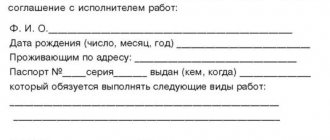Home / Labor Law / Employment / Employment contract / Collective labor agreement
Back
Published: 05/09/2017
Reading time: 9 min
0
5061
Article 56 of Part 3 of the Labor Code of the Russian Federation defines an employment contract (EA), reveals its main functions, and who concludes it. The following articles up to 67 are devoted to the content, terms and conditions of the agreement, as well as a description of the procedure for its execution.
One of the employer’s responsibilities before signing an employment contract is to familiarize the employee with the local regulations of the organization , including the collective labor agreement. Articles 40-44 of the Labor Code of the Russian Federation are dedicated to him.
- Individual TD Conditions Mandatory
- Additional
Dear readers! To solve your problem, call hotline 8 or ask a question on the website. It's free.
Ask a Question
The concept of an employment contract and its main features
From a legal point of view, an employment contract is a formal written agreement that can be concluded by the parties to a professional relationship if appropriate grounds arise. That is, in fact, this agreement cannot be concluded just like that. In order for it to truly have full legal force, the parties must have compelling reasons for its conclusion, provided for by law. The most common such reasons, which are most often encountered in practice, include the following events:
The complete list of certain circumstances under which the conclusion of an agreement will be a mandatory procedure may vary, depending on the specific situation.
If we talk about the main features that can be used to distinguish an employment contract from other legal documents, these include the following:
- Bilateral nature of the agreement. An agreement can always be concluded between two representatives of professional relations, namely between an employee and his employer. Moreover, the role of the latter can be either a legal entity or an individual registered as an individual entrepreneur.
- Personal nature of the agreement. Absolutely each employee is assigned individual job responsibilities that can only be performed by himself, without the involvement of any intermediaries or other persons.
- Subject nature of the contract. An employee always performs certain professional duties in accordance with his education, experience, as well as other important characteristics.
- Organizational nature of the agreement. An employment contract establishes important obligations towards the employer. In particular, the boss must organize for his subordinates proper working conditions that will be fully consistent with the specific area of professional activity of the organization.
- Compensatory nature of the contract. As you know, the main goal of absolutely any type of professional activity is, of course, for the employee to receive a regular income. Compliance with this rule is the strict responsibility of every employer. It is he who must promptly pay wages to his subordinates, as well as issue other required funds.
Separately, mention should be made of such an important characteristic of each employment contract as its validity period. As is known, all such agreements can be divided into two main types: those concluded for a certain period and those concluded for an indefinite period. The most popular are fixed-term contracts. This concept means that the agreement signed by the parties does not have an exact validity period. Consequently, the employee and his employer will not need to constantly renew the existing contract and worry about its expiration.
As for fixed-term contracts, they can only be concluded under certain conditions and circumstances. The exact list of such circumstances is established by modern legislative norms.
Parties and content
The parties to the collective labor agreement are the “Employer” and “Employees”, as indicated in the first introductory provision of the document, indicating the personal data of the official and the name of the organization.
The structure of the collective labor agreement is determined:
- introductory part;
- main provisions;
- conclusion.
Despite the fact that the specifics of each organization require a unique approach and the inclusion of the required nuances in the document.
The Ministry of Labor of the Russian Federation made the commission’s fate easier and offered for use the so-called “layout”, approved in the Letter from the city. It offers a comprehensive set of options and allows you to clearly reflect the structure of the document.
The content of the main part may include the following items:
- Providing employment. This defines the management positions required to allocate functional authority. As well as advantages and preferences for certain categories of workers.
- Working hours, rest times, vacations. Each provision provides the required characteristics and provides additional incentives.
- Salary. One of the most pressing issues in the discussion. Here are options for material incentives for certain categories of workers.
- Working conditions. Occupational safety protection. This provides for opportunities to improve sanitary standards and protect against negative man-made factors.
- Compensation for damage caused to health. Medical service. The provisions provide social guarantees for the receipt of herbs and injuries and discuss the possibilities of health prevention.
The collective labor agreement is filled out in the form established for drawing up contracts. There are no special requirements for it .
Collective agreement - its meaning and main features
As its name suggests, a collective labor agreement is concluded not with one employee, but with several at once. As a rule, such an agreement is signed, for example, with a trade union representative. It turns out that he, on behalf of all employees, agrees to the conditions specified in the collective labor agreement. However, the very fact that there is no individual procedure does not mean that each employee may not be familiar with the provisions of the concluded agreement. On the contrary, all subordinates must be aware of what information is included in the contract, what its main features are, etc.
To comply with the above rule, each employee puts his personal signature on a special sheet. This document can be issued in the form of an official annex to the main agreement. As a rule, all the names of employees are indicated on it, and opposite these names are their positions.
As a rule, the need to conclude a collective agreement arises in enterprises with a large number of employees. In this case, signing one document is much more convenient than constantly printing multiple contracts. If we are talking about enterprises with a small number of employees, here, as a rule, the need to conclude a collective agreement never arises at all.
Sometimes a collective agreement may also have an additional function - establishing various benefits and privileges for employees that are not basic and mandatory, for example:
- bonuses that can be timed to coincide with a variety of events - a company anniversary, an employee’s retirement, the birth of an employee’s child, etc.;
- payment for food, in full or in part. As existing statistics show, some enterprises actually still pay for meals for their employees. In this case, the procedure and features of providing this compensation, as well as other important nuances, must be fixed in the contract;
- the opportunity to visit various health facilities. As a rule, such benefits are often provided to employees whose professional activities involve increased danger, heavy physical labor, or various harmful factors. In this case, health procedures are carried out at the expense of the employer.
general information
Labor law defines a collective agreement as a normative document regulating social and labor relations in a single organization or structural unit, which primarily defends the rights of employees.
Its presence and the specifics of its conclusion are regulated by the Labor Code . The structure and content are based on agreements between employees (or their representatives - for example, a trade union cell) and the employer.
Typically, a collective agreement contains the following :
- conditions for organizing working time (length of the working day, break time, features of work outside of normal hours and weekends, etc.);
- the procedure for remuneration and bonuses;
- social guarantees related to health problems, complete or partial loss of ability to work (including due to injuries received at work), sanitary resort treatment;
conditions for providing rest time (additional payments in this regard);
- social guarantees associated with changes in the personal life of an employee - wedding, birth of a child;
- features of ensuring employee safety;
- the possibility of training, retraining, and advanced training of employees;
- other issues related to the professional activity and personal life of the employee.
The document is designed to financially and socially protect the employee, motivate him to conscientiously perform his duties and professional growth.
It should be understood that the collective agreement reflects those features of relations that were not reflected in other current regulations.
For example, if an enterprise has introduced regulations on wages, incentives and bonuses, there is no need to describe these nuances in detail in the collective agreement; it is enough to make a reference to the Regulations.
But this same provision can be included in the annexes to the collective agreement along with rules, schedules, agreements and other things.
The main differences between an individual employment contract and a collective one
You can identify a regular employment contract or a collective agreement by identifying the following differences between them:
- The conclusion of a standard employment contract always occurs on an individual basis. That is, one person acts on the employee’s side, as well as on the employer’s side. As for the procedure for concluding a collective agreement, an unlimited number of persons can act on behalf of employees. That is why such an agreement is often used in large enterprises with a large staff of employees.
- In most cases, an individual employment contract is concluded for an indefinite period – that is, without a limited period of validity. A collective agreement, on the contrary, can be concluded between the parties for no more than three calendar years. At the end of this period of time, the previously concluded collective agreement may be extended or completely terminated.
- The absence of an individual agreement between an employee and his employer will always be a gross violation of current legislation. As for the collective agreement, the parties are not generally obliged to conclude it. In most cases, this procedure is carried out at the initiative of the employer.
- When concluding an individual agreement, employers, as a rule, use standard forms of such agreements. At the same time, existing samples can be slightly adjusted, depending, for example, on the exact type of activity of the enterprise, as well as on other additional factors.
As for the procedure for drawing up a collective agreement, it should always be carried out on an individual basis. In this case, certain features and nuances of the functioning of a particular enterprise, the current level of its income, expenses, overall financial stability, etc. must be taken into account.
If such a need arises, changes can be easily made to the individual contract. To do this, the parties first discuss this issue and draw up an additional agreement to the existing agreement. As for the collective agreement, it will be much more difficult to make certain changes there. To do this, the employer will again need to negotiate with representatives of the trade union, discussing all the nuances.
Individual TD
In order to formalize the labor relationship between the employee and the employer,
both parties need to draw up and sign an employment contract, which will legislate their rights and obligations.
If you want to find out how to solve your particular problem in 2020, please contact us through the online consultant form or call :
The employee undertakes to perform a certain type of work activity and obey the internal regulations and standards of the employer, who for this is obliged to pay him a monetary remuneration and provide working conditions that meet safety regulations and legal standards.
An employment contract is drawn up between a specific person (individual), without the possibility of replacing him, and the employer or his legal representative.
Conditions
The content of an individual TD is a number of conditions by agreement of the parties and those that must be included according to the rules of the current legislation and cannot be agreed upon by the parties. These are mandatory conditions and additional ones.
Read more: Internal passport of a citizen of the Russian Federation
Mandatory
Mandatory conditions include:
- about the work being performed;
- about the position that the employee will hold during the contract:
- about the employee’s workplace;
- about the duration of the contract.
An individual employment contract can be concluded for a certain time, then it is called a fixed-term one. The term must be five years or less. In such an agreement, a mandatory clause is the expiration date of its validity. This type of agreement is possible in two cases:
- if the nature of the work performed will be temporary (seasonal) in nature;
- if an employee is hired to replace a temporarily absent employee.
If the end date is not specified, the contract is of an unlimited duration and will be terminated by agreement of the parties or in other cases provided by law.
If you want to find out how to solve your particular problem, please contact us through the online consultant form or call :
Additional
Additional conditions include those that do not directly relate to the employee’s work: living conditions, the possibility of providing housing, food, etc. Additional terms and conditions may not be specified.
Another important part of the content of the TD is information about both parties:
- Full name of the employee and employer, if he is an individual; name of company;
- data on identification documents of the employee and employer;
- details of the employer's representative authorized to sign the contract;
- place where the contract was concluded, date.
What is more important - a collective agreement or an individual one?
The question of which of the possible employment contracts is more important can be answered quite confidently. The most significant is the individual employment contract, if only because its existence is a mandatory condition enshrined at the legislative level. The performance by an employee of his professional duties without prior conclusion of an employment contract will always be considered a serious violation of existing standards. This, in turn, is a valid basis for the subsequent establishment of monetary fines, as well as other types of punishment.
If we talk about the absence of a collective agreement at the enterprise, this fact cannot be the basis for imposing legislative liability measures. That is, in fact, a collective agreement can be called a kind of “bonus” from the employer, since it is there that he can provide his subordinates with various additional privileges.
Answers to common questions
Question: Is a collective agreement a local regulatory document of the organization?
Answer: No, a collective agreement is not a local regulatory document, since its publication is initiated by the employer and directly expresses his decision on certain issues.
Question: Who are the parties to the collective agreement?
Answer: According to Art. 40 of the Labor Code of the Russian Federation, representatives of the employer and representatives of the employee act as parties to the collective agreement. As a rule, the head of the company himself acts as the representative of the employer. But he can shift his responsibilities on this issue to a specific employee by appropriate order.
Results
Thus, the procedure for concluding an employment contract represents the most important stage in modern professional relations. It is at this stage that the parties acquire formal rights, as well as important obligations. The procedure for signing the agreement itself will include the following steps:
- First, the parties must have a certain basis for concluding an employment contract. In most cases, this basis is the employment of a new employee for a vacant position in the organization.
- Then the parties can proceed to signing the document itself. As a rule, most enterprises use a standard form of an individual employment contract, which can be supplemented with various individual information. If the employer wishes to conclude a collective agreement, the form of this document is most often developed on an individual basis.
- After all formalities have been completed, the employee must carefully study the provisions of the contract presented to him. If everything suits him, he puts his signature in the right place, at the very end of the document.
Urgent
A specific calendar date, event or moment of signing is the start date of the collective agreement. Its final provisions specify the exact expiration date.
By default, a collective agreement is concluded for no more than 3 years. If the current collective agreement suits the employees, no later than three months before the end of its validity period, they must again initiate negotiations on the extension of the collective bargaining agreement. Or a new version of the Agreement is being worked out.
Moreover, if the enterprise simply changes its name, the collective agreement continues to be valid. A change of director is not grounds for termination.
If an enterprise changes its form of ownership , the collective agreement is valid for three months thereafter. Then a new Agreement is concluded. In the event of reorganization or liquidation, the Agreement continues until the end of the procedure for accession, merger, and so on.
Invitation to negotiations
As a rule, the active group is selected from among the employees. Some employers themselves propose drawing up a collective labor agreement because these requirements are increasingly tacitly, and sometimes with direct instructions, motivating its conclusion.
The initiating party submits a proposal for negotiations in writing. The counterparty within 7 days from the date of receipt gives a positive response or motivates the reasons for the refusal .
If the reasons for the refusal are not convincing, they can be disputed with the labor inspectorate (GTI). After receiving written consent, a commission is formed to participate in the negotiations.
The day following receipt of the written response opens the negotiation period between the parties.
The text of the response must contain a list of members of the commission participating in the negotiations, which is determined by clauses 1.2 of Art. 36 Labor Code of the Russian Federation.
Typically, the members of the commission include representatives of the divisions of the enterprise, which is regulated by clauses 2-5 of Art. 37 Labor Code of the Russian Federation.
Individual entrepreneurs have the right to nominate responsible persons from among themselves, or enter into negotiations collectively if their number does not exceed 5 people.
Trade union members are notified through the trade union organization and provide lists of elected representatives.
No later than 2 days before the start of negotiations, the counterparties exchange available information. This gives them the opportunity to prepare for negotiations, which confirms clause 7 of Art. 37 Civil Code of the Russian Federation.
During negotiations, preliminary text matching takes place. If the parties do not reach an agreement, negotiations are postponed .
The duration of the negotiation period is generally limited to
3 months . If during this time an agreement is not reached, a preliminary text is drawn up, to which protocols of disagreements between the parties are separately attached in accordance with Parts 2 and 3 of Art. 40 Labor Code of the Russian Federation .
A ready-made agreed text or a preliminary copy with protocols of disagreements is presented to the meeting to approve the contract.
Form
The structure of the collective agreement and the obligations of the parties are worked out in accordance with the law on collective agreements.
It is based on the following sections:
general position and definition of the Parties;
- rights and obligations of all parties to the Agreement;
- determination of work and rest time;
- payment and conditions (standardization) of work;
- social guarantees;
- conditions for retraining, vocational training and advanced training;
- occupational Safety and Health;
- settlement of disputes;
- obligations to fulfill the terms of the Agreement;
- final provisions;
- applications.
As a basis, you can take the sample we proposed and the form of the employment contract.










